南越王墓博物馆英语稿
- 格式:doc
- 大小:30.50 KB
- 文档页数:1
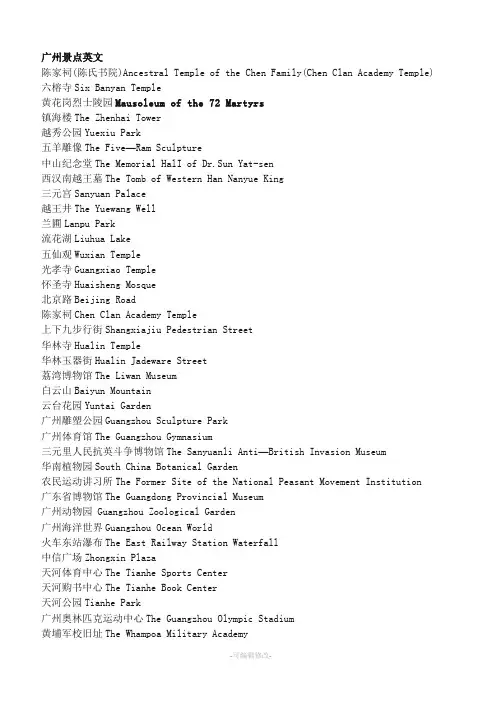
广州景点英文陈家祠(陈氏书院)Ancestral Temple of the Chen Family(Chen Clan Academy Temple) 六榕寺Six Banyan Temple黄花岗烈士陵园Mausoleum of the 72 Martyrs镇海楼The Zhenhai Tower越秀公园Yuexiu Park五羊雕像The Five—Ram Sculpture中山纪念堂The Memorial HalI of Dr.Sun Yat-sen西汉南越王墓The Tomb of Western Han Nanyue King三元宫Sanyuan Palace越王井The Yuewang Well兰圃Lanpu Park流花湖Liuhua Lake五仙观Wuxian Temple光孝寺Guangxiao Temple怀圣寺Huaisheng Mosque北京路Beijing Road陈家祠Chen Clan Academy Temple上下九步行街Shangxiajiu Pedestrian Street华林寺Hualin Temple华林玉器街Hualin Jadeware Street荔湾博物馆The Liwan Museum白云山Baiyun Mountain云台花园Yuntai Garden广州雕塑公园Guangzhou Sculpture Park广州体育馆The Guangzhou Gymnasium三元里人民抗英斗争博物馆The Sanyuanli Anti—British Invasion Museum华南植物园South China Botanical Garden农民运动讲习所The Former Site of the National Peasant Movement Institution广东省博物馆The Guangdong Provincial Museum广州动物园 Guangzhou Zoological Garden广州海洋世界Guangzhou Ocean World火车东站瀑布The East Railway Station Waterfall中信广场Zhongxin Plaza天河体育中心The Tianhe Sports Center天河购书中心The Tianhe Book Center天河公园Tianhe Park广州奥林匹克运动中心The Guangzhou Olympic Stadium黄埔军校旧址The Whampoa Military Academy南海神庙Nanhai God Temple莲花山Lianhua Mountain宝墨园Baomo Garden余荫园Yuyin Garden长隆夜间野生动物园Changlong Night Zoo南沙天后宫The Nansha Tianhou Palace孙中山大元帅府纪念馆The Sun Yet-sen's Generalissimo Mansion海幢寺Haizhuang Temple瀛洲生态公园Yingzhou Ecological Park芙蓉嶂旅游度假区The Furongzhang Holiday Resod盘古皇庙Panguhuang Temple洪秀全纪念馆The Memorial Museum of Hong Xiuquan花都广场Huadu Square珠江沿岸景观The Landscapes along the Zhujiang River珠江航游The Zhuiiang River Cruise沙面岛Shamian Island南方大厦The Nanfang Mansion爱群大厦The Aiqun Mansion海珠广场Haizhu Plaza石室圣心大教堂The Sacred Heart Cathedral二沙岛Ersha Island广州国际会展中心The Guangzhou International Convention and Exhibition Center 北回归线广州标志塔The Guangzhou Marking Tower of the Tropic of Cancer从化温泉度假区The Conghua Hot Spring Resort天湖游览区The Tianhu Sightseeing Zone流溪河国家森林公园Liuxihe National Forest Park白水寨省级风景名胜区The Baishuizhai Provincial Scenic Spot何仙姑家庙Hexiangu Temple挂绿广场Gual0 Plaza鸦片战争纪念馆The Museum of the Opium War佛山市Foshan city梁园Liang Garden清晖园Qinghui Garden佛山祖庙Foshan Ancestral Temple黄飞鸿纪念堂The Memorial Hal l of Huang Feihong西樵山度假区The Xiqiao Mountain Tourist Resort鼎湖山度假区The Dinghu Mountain Tourist Resort迎春花市The Spring Festival Flower Fair舞狮The Lion Dance元宵节The Lantern Festival 番禺莲花节The Lotus Festival in Panyu 重阳节The Double—Ninth Festival龙舟节The Dragon Boat Festival南海神诞辰(波罗诞)The Birthday of the God of the South Sea(The Boluo Dan)THANKS致力为企业和个人提供合同协议,策划案计划书,学习课件等等打造全网一站式需求欢迎您的下载,资料仅供参考。
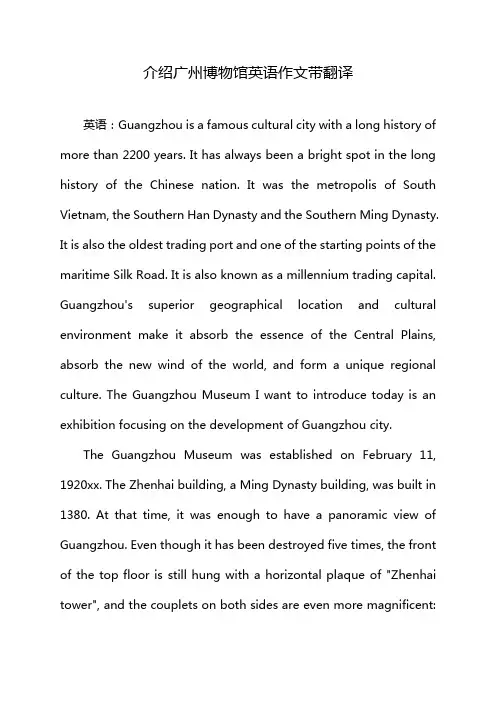
介绍广州博物馆英语作文带翻译英语:Guangzhou is a famous cultural city with a long history of more than 2200 years. It has always been a bright spot in the long history of the Chinese nation. It was the metropolis of South Vietnam, the Southern Han Dynasty and the Southern Ming Dynasty. It is also the oldest trading port and one of the starting points of the maritime Silk Road. It is also known as a millennium trading capital. Guangzhou's superior geographical location and cultural environment make it absorb the essence of the Central Plains, absorb the new wind of the world, and form a unique regional culture. The Guangzhou Museum I want to introduce today is an exhibition focusing on the development of Guangzhou city.The Guangzhou Museum was established on February 11, 1920xx. The Zhenhai building, a Ming Dynasty building, was built in 1380. At that time, it was enough to have a panoramic view of Guangzhou. Even though it has been destroyed five times, the front of the top floor is still hung with a horizontal plaque of "Zhenhai tower", and the couplets on both sides are even more magnificent:"thousands of robberies, dangerous buildings still exist. Ask who will pick the Mo Xiao, and the eyes are empty today and ancient; 500 years ago, Hou an was there, so I leaned against the fence to watch the sword and shed tears on the hero". In the early years of the Republic of China, people of insight believed that all civilized countries in the world had grand museums, and Guangzhou was the most prosperous place in the country. It was also "the source of Guangdong's revolutionary policies and the province of birth". Therefore, they chose Zhenhai tower as the site of the museum. The Guangzhou Municipal Museum is the first public museum in South China and one of the earliest museums in China. In that time when the country was in peril, she was endowed with the history of "saving the nation from subjugation and ensuring its survival and developing the wisdom of the people"mission. Since then, Zhenhai tower, which has been a "Xiongzhen Haijiang" for hundreds of years, has become the old landmark of Guangzhou. Since everyone has visited Zhenhai tower during the summer vacation, I will not introduce the cultural relics on display one by one. Briefly, I have some ideas after my visit. As Ijust said, Guangzhou is a commercial capital with a long history. According to archaeological findings, there are many Neolithic remains here, which is enough to prove that there were human footprints here thousands of years ago. Although not as good as Xi'an and other ancient capitals in the world, the cultural heritage of Guangzhou can not be ignored. Therefore, I sincerely feel that the people who made some remarks against Guangzhou for its lack of history and culture are very uneducated.On the contrary, a considerable number of people do not pay attention to the culture of Guangzhou. In the previous speech, many students said that if it wasn't for the homework requirements, they had never even been to the Nanyue King's tomb museum. Some students have visited museums outside the province, such as Mawangdui, Terra Cotta Warriors, etc. because of their tourism, and they are like a few treasures, forming a sharp contrast. As a person living in Guangzhou, if he doesn't take the initiative to understand the history and culture of Guangzhou, how can he ask foreign tourists to explore our culture? So no matter whether we are from Guangzhou or not, as long as we live in this city, we have theobligation and responsibility to love this city and carry forward the culture here, so that Guangzhou can truly become a famous historical and cultural city in the eyes of all people.广州是一个拥有2200多年悠久历史的文化名城,一直以来都是中华民族历史长河中的一个亮点,她是南越、南汉、南明三朝都会,是历史最悠久的通商口岸、海上丝绸之路的起点之一,更有千年商都之称。
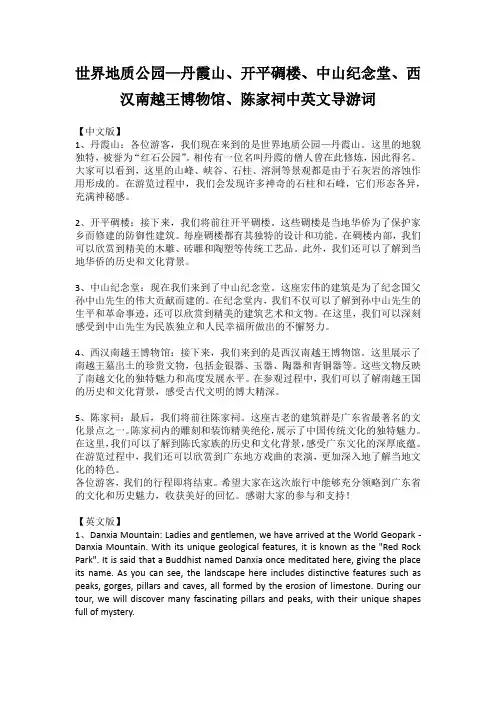
世界地质公园—丹霞山、开平碉楼、中山纪念堂、西汉南越王博物馆、陈家祠中英文导游词【中文版】1、丹霞山:各位游客,我们现在来到的是世界地质公园—丹霞山。
这里的地貌独特,被誉为“红石公园”。
相传有一位名叫丹霞的僧人曾在此修炼,因此得名。
大家可以看到,这里的山峰、峡谷、石柱、溶洞等景观都是由于石灰岩的溶蚀作用形成的。
在游览过程中,我们会发现许多神奇的石柱和石峰,它们形态各异,充满神秘感。
2、开平碉楼:接下来,我们将前往开平碉楼。
这些碉楼是当地华侨为了保护家乡而修建的防御性建筑。
每座碉楼都有其独特的设计和功能。
在碉楼内部,我们可以欣赏到精美的木雕、砖雕和陶塑等传统工艺品。
此外,我们还可以了解到当地华侨的历史和文化背景。
3、中山纪念堂:现在我们来到了中山纪念堂。
这座宏伟的建筑是为了纪念国父孙中山先生的伟大贡献而建的。
在纪念堂内,我们不仅可以了解到孙中山先生的生平和革命事迹,还可以欣赏到精美的建筑艺术和文物。
在这里,我们可以深刻感受到中山先生为民族独立和人民幸福所做出的不懈努力。
4、西汉南越王博物馆:接下来,我们来到的是西汉南越王博物馆。
这里展示了南越王墓出土的珍贵文物,包括金银器、玉器、陶器和青铜器等。
这些文物反映了南越文化的独特魅力和高度发展水平。
在参观过程中,我们可以了解南越王国的历史和文化背景,感受古代文明的博大精深。
5、陈家祠:最后,我们将前往陈家祠。
这座古老的建筑群是广东省最著名的文化景点之一。
陈家祠内的雕刻和装饰精美绝伦,展示了中国传统文化的独特魅力。
在这里,我们可以了解到陈氏家族的历史和文化背景,感受广东文化的深厚底蕴。
在游览过程中,我们还可以欣赏到广东地方戏曲的表演,更加深入地了解当地文化的特色。
各位游客,我们的行程即将结束。
希望大家在这次旅行中能够充分领略到广东省的文化和历史魅力,收获美好的回忆。
感谢大家的参与和支持!【英文版】1、Danxia Mountain: Ladies and gentlemen, we have arrived at the World Geopark -Danxia Mountain. With its unique geological features, it is known as the "Red Rock Park". It is said that a Buddhist named Danxia once meditated here, giving the place its name. As you can see, the landscape here includes distinctive features such as peaks, gorges, pillars and caves, all formed by the erosion of limestone. During our tour, we will discover many fascinating pillars and peaks, with their unique shapes full of mystery.2、KaiPing DiaOLou: Next, we will visit the DiaOLou in KaiPing. These defensive buildings were built by local overseas Chinese to protect their hometowns. Each DiaOLou has its unique design and function. Inside the DiaOLou, we can admire exquisite traditional crafts such as woodcarving, brick carving and pottery. In addition, we can learn about the history and cultural background of the local overseas Chinese.3、Sun Yat-sen Memorial Hall: Now, we have arrived at the Sun Yat-sen Memorial Hall. This magnificent building was constructed to commemorate the great contributions of Dr. Sun Yat-sen, known as the father of the nation. Inside the hall, we can not only learn about Dr. Sun Yat-sen's life and revolutionary deeds, but also admire the exquisite architectural art and cultural relics. Here, we can deeply feel the unremitting efforts Dr. Sun Yat-sen made for national independence and people's happiness.4、Western Han Dynasty Nanyue King Museum: Next, we will visit the Western Han Dynasty Nanyue King Museum. This museum showcases precious cultural relics unearthed from the Nanyue Tombs, including gold and silver artifacts, jade and pottery. These artifacts reflect the unique charm and highly developed level of Nanyue culture. During the visit, we can learn about the history and cultural background of the Nanyue Kingdom and experience the grandeur of ancient civilization.5、Chen Clan Ancestral Hall: Finally, we will visit the Chen Clan Ancestral Hall. This ancient complex is one of the most famous cultural attractions in Guangdong province. The carvings and decorations inside the Chen Clan Ancestral Hall are exquisite, demonstrating the unique charm of traditional Chinese culture. Here, we can learn about the history and cultural background of the Chen family and experience the deep cultural heritage of Guangdong. During our tour, we can also enjoy performances of local operas in Guangdong to gain a deeper understanding of local cultural characteristics.。
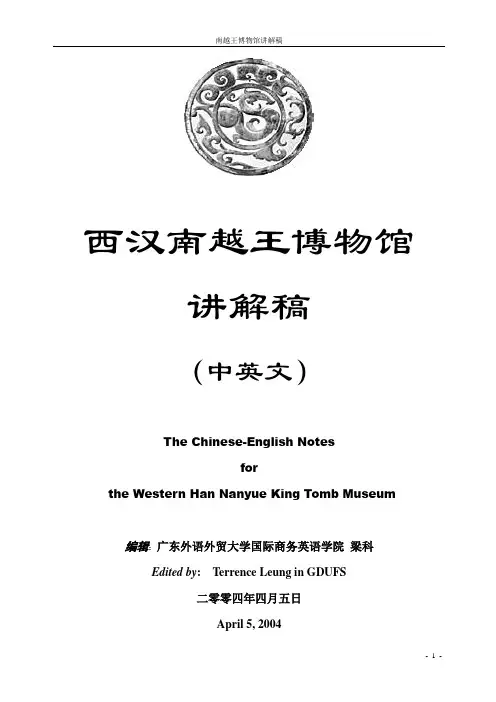
西汉南越王博物馆讲解稿(中英文)The Chinese-English Notesforthe Western Han Nanyue King Tomb Museum编辑:广东外语外贸大学国际商务英语学院梁科Edited by: Terrence Leung in GDUFS二零零四年四月五日April 5, 2004各位朋友:欢迎来到南越王墓博物馆。
首先我给大家介绍一下博物馆的基本情况。
我们博物馆的基本陈列有三个部分。
在大家右手边的是第一展馆――杨永德伉俪捐赠藏枕专题陈列,这个我们可以在回程时再参观。
那么在上面还有另外两个展馆,一个是南越王墓原址,一个是南越王墓出土文物陈列。
大家跟我上来吧。
Welcome to the The Nanyue King Museum. It’s cloudy outside, but I will try my best to cheer you up.Well, first I would love to give you a brief introduction to the museum. There are all together three exhibition rooms and on your right hand is the first one. It displays the more than 200 ceramic pillows donated by hongkong collector Mr.&Mrs.Yeung. We will enjoy them when we are on our way back.. Now please follow me and I will lead you to the original site of the tomb.(在去墓原址的途中) 说到南越王墓的发现,这确实是个偶然。
它是在1983年6月建筑施工中被发现的。
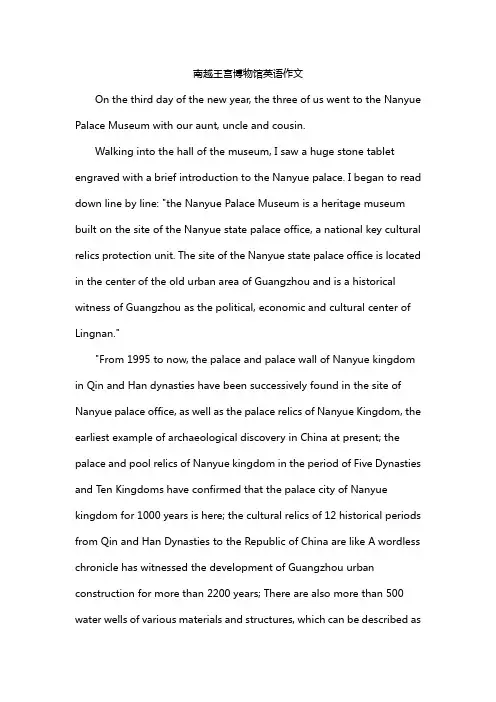
南越王宫博物馆英语作文On the third day of the new year, the three of us went to the Nanyue Palace Museum with our aunt, uncle and cousin.Walking into the hall of the museum, I saw a huge stone tablet engraved with a brief introduction to the Nanyue palace. I began to read down line by line: "the Nanyue Palace Museum is a heritage museum built on the site of the Nanyue state palace office, a national key cultural relics protection unit. The site of the Nanyue state palace office is located in the center of the old urban area of Guangzhou and is a historical witness of Guangzhou as the political, economic and cultural center of Lingnan.""From 1995 to now, the palace and palace wall of Nanyue kingdom in Qin and Han dynasties have been successively found in the site of Nanyue palace office, as well as the palace relics of Nanyue Kingdom, the earliest example of archaeological discovery in China at present; the palace and pool relics of Nanyue kingdom in the period of Five Dynasties and Ten Kingdoms have confirmed that the palace city of Nanyue kingdom for 1000 years is here; the cultural relics of 12 historical periods from Qin and Han Dynasties to the Republic of China are like A wordless chronicle has witnessed the development of Guangzhou urban construction for more than 2200 years; There are also more than 500 water wells of various materials and structures, which can be described asa natural water well culture museum! "After reading the introduction, I learned that the Nanyue palace is a great building with a history of thousands of years!Then we visited three exhibition halls. Now let me talk about what the following three exhibition halls are talking about.Exhibition hall 1: Nanyue PalaceThe archaeological relics of palaces and gardens have untied the "mysterious veil" of Nanyue 2200 years ago. The exhibition made me feel as if I had walked into the Nanyue palace and learned about the history of Nanyue, the palace and garden construction system, the outstanding achievements in cultural communication and national integration. Isn't it great?The second exhibition hall: the palace of the Southern Han Dynasty The Southern Han Dynasty was the second local political power to establish the capital of Guangzhou in history, which had a significant impact on the urban development of Guangzhou. This part mainly shows the achievements of the Southern Han Dynasty in politics, economy, capital construction and overseas cultural exchanges through archaeological discoveries.Exhibition hall 3: the famous city Guangzhou 2000The site of Nanyue state palace office contains cultural relics from 12 historical periods from the Qin Dynasty to the Republic of China. Like aphysical history book, it shows the urban construction process of Guangzhou for more than 2200 years. This part combines the "time and space memory" of unearthed cultural relics and historical scenes.During this visit, I gained a lot of knowledge. Learned a lot. This makes me know the millennium history of Guangzhou.。
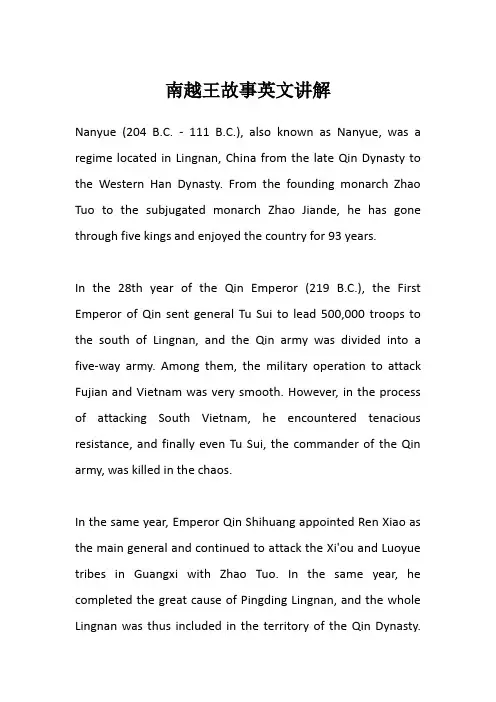
南越王故事英文讲解Nanyue (204 B.C. -111 B.C.), also known as Nanyue, was a regime located in Lingnan, China from the late Qin Dynasty to the Western Han Dynasty. From the founding monarch Zhao Tuo to the subjugated monarch Zhao Jiande, he has gone through five kings and enjoyed the country for 93 years.In the 28th year of the Qin Emperor (219 B.C.), the First Emperor of Qin sent general Tu Sui to lead 500,000 troops to the south of Lingnan, and the Qin army was divided into a five-way army. Among them, the military operation to attack Fujian and Vietnam was very smooth. However, in the process of attacking South Vietnam, he encountered tenacious resistance, and finally even Tu Sui, the commander of the Qin army, was killed in the chaos.In the same year, Emperor Qin Shihuang appointed Ren Xiao as the main general and continued to attack the Xi'ou and Luoyue tribes in Guangxi with Zhao Tuo. In the same year, he completed the great cause of Pingding Lingnan, and the whole Lingnan was thus included in the territory of the Qin Dynasty.Qin Shihuang set up three counties in Lingnan: Guilin County, Xiang County and Nanhai County, all of which were arrogantly restrained by Nanhai Wei.In the second year of Qin II (208 B.C.), Ren Chao was seriously ill. He summoned Zhao Tuo, the order of Longchuan, told him to build the country by the mountains and the sea in Nanhai County, and immediately issued an appointment document to Zhao Tuo to take his place in Nanhai County. After Ren Xiao's death, Zhao Tuo spread a polemic to Hengpu, Yangshan, Huangxuan and other passes, saying, "The army of robbers is coming. We should cut off the road quickly and gather the army to defend ourselves." All major traffic routes on Wuling have been blocked, and all links with Lingbei area have been cut off. At this time, due to the chaos in the Central Plains, some Yue tribes in Guilin County and Xiang County were also independent one after another and were no longer tempered by Nanhai Wei.During Zhao Tuo's succession, when the Han Gao was in power, he listened to the opinions of the slanderous ministers, regarded the barbarians as alien, and cut off the source of utensils needed by South Vietnam. Guessing was the idea ofthe King of Changsha. He wanted to rely on the Han Dynasty in the Central Plains to destroy South Vietnam and become the king of South Vietnam, and make his own contributions. Therefore, Zhao Tuo led a large army to attack Changsha and defeated several counties before leaving.In the second year of Emperor Gaozu of the Han Dynasty (205 BC), Zhao Tuo launched a war against Guilin County and Xiang County. Through military repression, Zhao Tuo basically restored the three counties of Lingnan established by Qin and realized the reunification of Lingnan.Zhao Tuo was called by the heavily ill Nanhai County Lieutenant Ren arrogant and went to Panyu south of the Yangtze River. After passing through the ancient bamboo, he saw the king of Yue rise from the ground. He was majestic. Looking around the wild, he calmly analyzed the general trend of the world in the face of the stone wall and felt that the time was ripe, so he aspired to be king.There are also relics such as Qiankun Stone, Mianbiyan, Guzhaimen, Iron Farm and so on Yuewang Mountain. Relying onZhao Tuo's legendary story, Yuewang Mountain also has a series of historical relics related to the king of Yue, so that future generations can cross time and space while climbing Yuewang Mountain and think about the story and footprints of the legendary king of South Yue.。
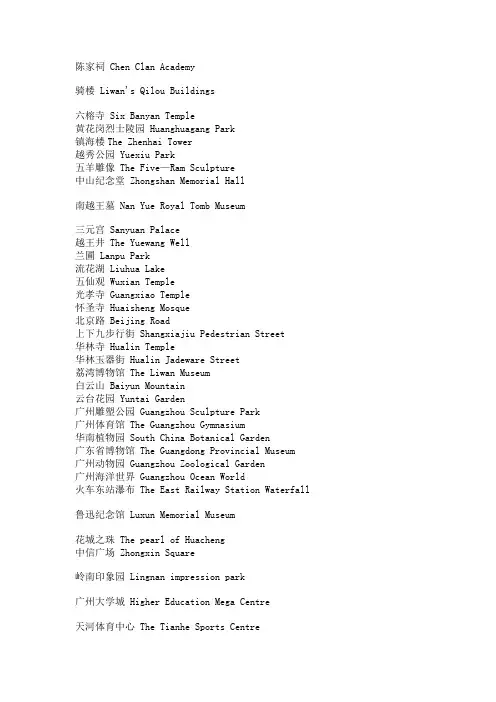
陈家祠 Chen Clan Academy骑楼 Liwan's Qilou Buildings六榕寺 Six Banyan Temple黄花岗烈士陵园 Huanghuagang Park镇海楼The Zhenhai Tower越秀公园 Yuexiu Park五羊雕像 The Five—Ram Sculpture中山纪念堂 Zhongshan Memorial Hall南越王墓 Nan Yue Royal Tomb Museum三元宫 Sanyuan Palace越王井 The Yuewang Well兰圃 Lanpu Park流花湖 Liuhua Lake五仙观 Wuxian Temple光孝寺 Guangxiao Temple怀圣寺 Huaisheng Mosque北京路 Beijing Road上下九步行街 Shangxiajiu Pedestrian Street华林寺 Hualin Temple华林玉器街 Hualin Jadeware Street荔湾博物馆 The Liwan Museum白云山 Baiyun Mountain云台花园 Yuntai Garden广州雕塑公园 Guangzhou Sculpture Park广州体育馆 The Guangzhou Gymnasium华南植物园 South China Botanical Garden广东省博物馆 The Guangdong Provincial Museum广州动物园 Guangzhou Zoological Garden广州海洋世界 Guangzhou Ocean World火车东站瀑布 The East Railway Station Waterfall 鲁迅纪念馆 Luxun Memorial Museum花城之珠 The pearl of Huacheng中信广场 Zhongxin Square岭南印象园 Lingnan impression park广州大学城 Higher Education Mega Centre天河体育中心 The Tianhe Sports Centre天河购书中心 The Tianhe Book Center天河公园 Tianhe Park广州奥林匹克运动中心 The Guangzhou Olympic Stadium黄埔军校旧址 The Whampoa Military Academy南海神庙Nanhai Temple莲花山Lianhua Mountain宝墨园Baomo Garden余荫园Yuyin Garden长隆夜间野生动物园 Changlong Night Zoo海幢寺Haizhuang Temple瀛洲生态公园Yingzhou Ecological Park盘古皇庙Panguhuang Temple花都广场Huadu Square珠江The Pearl River珠江沿岸景观The Landscapes along the Zhujiang River珠江航游The Zhuiiang River Cruise沙面岛 Shamian Island海珠广场 Haizhu Square石室圣心大教堂 The Sacred Heart Cathedral二沙岛 Ersha Island广州国际会展中心 The Guangzhou International Convention and Exhibition Center北回归线广州标志塔 The Guangzhou Marking Tower of the Tropic of Cancer 从化温泉度假区The Conghua Hot Spring Resort天湖游览区The Tianhu Sightseeing Zone流溪河国家森林公园Liuxihe National Forest Park白水寨省级风景名胜区The Baishuizhai Provincial Scenic Spot何仙姑家庙Hexiangu Temple挂绿广场Gualv Square梁园Liang Garden清晖园Qinghui Garden佛山祖庙Foshan Ancestral Temple黄飞鸿纪念堂The Memorial Hall of Huang Feihong。
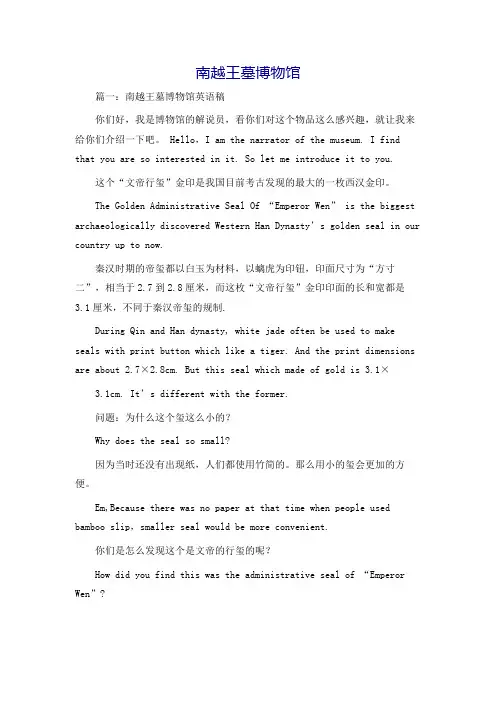
南越王墓博物馆篇一:南越王墓博物馆英语稿你们好,我是博物馆的解说员,看你们对这个物品这么感兴趣,就让我来给你们介绍一下吧。
Hello,I am the narrator of the museum. I findthat you are so interested in it. So let me introduce it to you.这个“文帝行玺”金印是我国目前考古发现的最大的一枚西汉金印。
The Golden Administrative Seal Of “Emperor Wen” is the biggest archaeologically discovered Western Han Dynasty’s golden seal in our country up to now.秦汉时期的帝玺都以白玉为材料,以螭虎为印钮,印面尺寸为“方寸二”,相当于2.7到2.8厘米,而这枚“文帝行玺”金印印面的长和宽都是3.1厘米,不同于秦汉帝玺的规制.During Qin and Han dynasty, white jade often be used to make seals with print button which like a tiger. And the print dimensions are about 2.7×2.8cm. But this seal which made of gold is 3.1×3.1cm. It’s different with the former.问题:为什么这个玺这么小的?Why does the seal so small?因为当时还没有出现纸,人们都使用竹简的。
那么用小的玺会更加的方便。
Em,Because there was no paper at that time when people used bamboo slip,smaller seal would be more convenient.你们是怎么发现这个是文帝的行玺的呢?How did you find this was the administrative seal of “Emperor Wen”?当我们发现这个金印的时候,它是放在墓主人的胸前的。
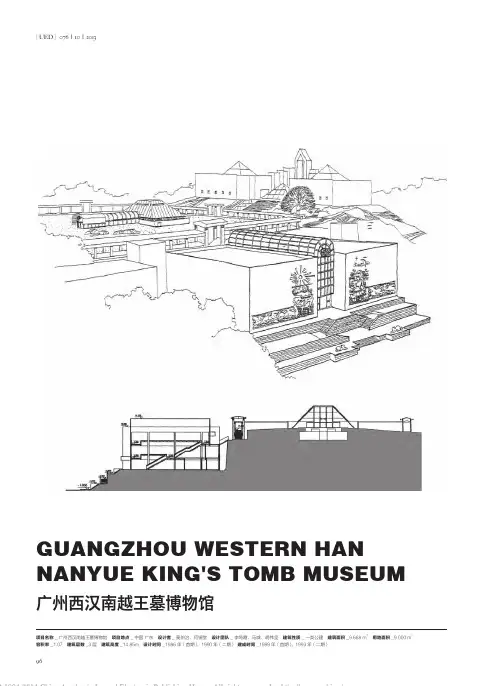
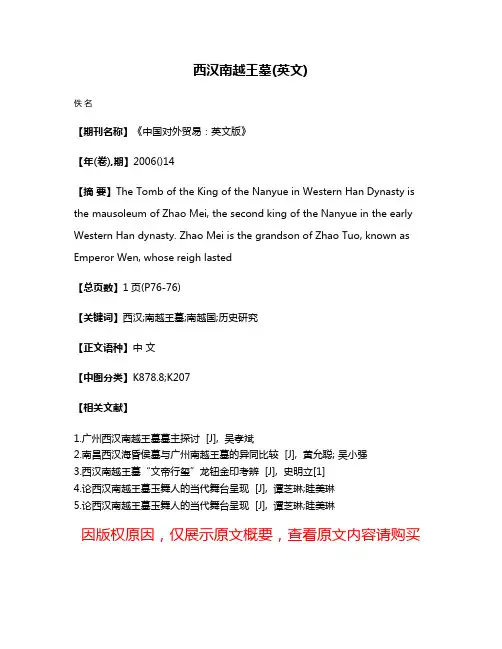
西汉南越王墓(英文)
佚名
【期刊名称】《中国对外贸易:英文版》
【年(卷),期】2006()14
【摘要】The Tomb of the King of the Nanyue in Western Han Dynasty is the mausoleum of Zhao Mei, the second king of the Nanyue in the early Western Han dynasty. Zhao Mei is the grandson of Zhao Tuo, known as Emperor Wen, whose reigh lasted
【总页数】1页(P76-76)
【关键词】西汉;南越王墓;南越国;历史研究
【正文语种】中文
【中图分类】K878.8;K207
【相关文献】
1.广州西汉南越王墓墓主探讨 [J], 吴孝斌
2.南昌西汉海昏侯墓与广州南越王墓的异同比较 [J], 黄允聪; 吴小强
3.西汉南越王墓“文帝行玺”龙钮金印考辨 [J], 史明立[1]
4.论西汉南越王墓玉舞人的当代舞台呈现 [J], 谭芝琳;眭美琳
5.论西汉南越王墓玉舞人的当代舞台呈现 [J], 谭芝琳;眭美琳
因版权原因,仅展示原文概要,查看原文内容请购买。
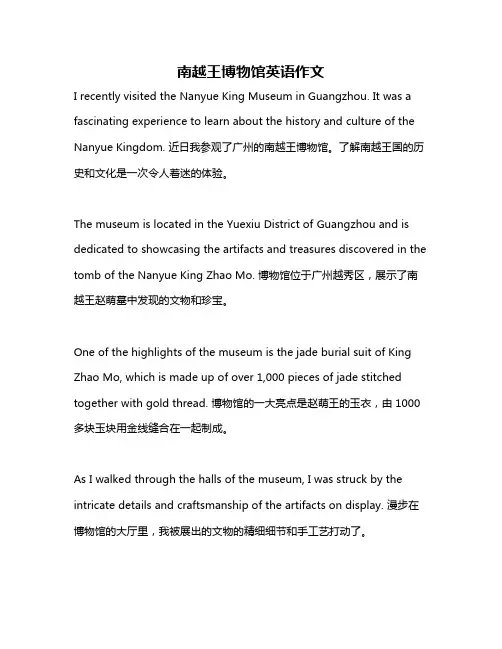
南越王博物馆英语作文I recently visited the Nanyue King Museum in Guangzhou. It was a fascinating experience to learn about the history and culture of the Nanyue Kingdom. 近日我参观了广州的南越王博物馆。
了解南越王国的历史和文化是一次令人着迷的体验。
The museum is located in the Yuexiu District of Guangzhou and is dedicated to showcasing the artifacts and treasures discovered in the tomb of the Nanyue King Zhao Mo. 博物馆位于广州越秀区,展示了南越王赵萌墓中发现的文物和珍宝。
One of the highlights of the museum is the jade burial suit of King Zhao Mo, which is made up of over 1,000 pieces of jade stitched together with gold thread. 博物馆的一大亮点是赵萌王的玉衣,由1000多块玉块用金线缝合在一起制成。
As I walked through the halls of the museum, I was struck by the intricate details and craftsmanship of the artifacts on display. 漫步在博物馆的大厅里,我被展出的文物的精细细节和手工艺打动了。
The museum also features a replica of the Nanyue King's tomb, giving visitors a sense of the grandeur and opulence of the ancient burial site. 博物馆还展示了南越王的陵墓复制品,让游客感受到古代墓地的宏伟和奢华。
南越王墓英文导游词篇一:20XX年西汉南越王墓导游词西汉南越王墓一、概况西汉南越王墓位于广州解放北路的象岗山上,是西汉初年南越王国第二代王赵眜的陵墓。
赵眜是赵佗的孙子,号称文帝,公元前137年至122年在位。
南越文王墓的出土,被誉为近代中国考古五大新发现之一,现已辟为博物馆。
1983年,在解放北路象岗山上一个工地发现的这个大墓。
深入地下20米,用750多块砂岩大石构筑。
陵墓面积约100平方米,分前后两部分,共有7个室。
前室居中,室的四面及顶部都绘有朱、墨两色的云纹图案,象征朝堂。
斜坡墓道残长10.46米,宽2.36~2.59米。
墓内的前、后两部分各设有一道双扇的石门。
南越王墓是岭南地区发现规模最大、出土文物最丰富多样、墓主人身份规格最高的一座汉墓,是中国境内迄今发现年代最早的彩绘壁画石室大墓。
这座墓堪称地下宝库,共出土各类文物达1000多件(套),内涵非常丰富,尤以铜、铁、陶、玉四者所占比重最大。
而“文帝行玺”金印是中国考古发掘首次发现的“皇帝”印玺,最为珍贵。
二、金印、金带钩与金花泡“镇墓之宝”——“文帝行玺”金印,是我国考古发掘出土的第一枚帝印。
在传世或发掘出土秦汉印章中,未见一枚皇帝印玺,只有文献记载。
但是文献讲的帝印,是白玉质印、螭虎钮印,印文是“皇帝行玺”或“天子行玺”;而南越国赵昧这枚帝印却是金质印、蟠龙钮印,印文是“文帝行玺”。
这是金印的独特之处,是南越国自铸、生前实用之印。
南越王墓除了“文帝行玺”金印外,还有“泰子”(泰同太)金印和“右夫人玺”金印,但不是龙钮,而是龟钮。
“泰子”金印也是首次发现,在传世印玺中未曾见过。
南越王墓的金器除金印外,还有金带钩、金花泡和杏形金叶,均为饰物。
而金花泡普遍被认为是海外输入的“洋货”.三、银盒、银洗与银带钩南越王墓出土文物中有一件白色的银盒特别引人注目,这个呈扁球形银盒在出土时在主棺室,盒内有十盒药丸。
从造型、纹饰和口沿的鎏金圈套等工艺特点看,与中国传统的器具风格迥异,经分析研究,认为是波斯产品,里面的药丸很可能是阿拉伯药。
参观南越王宫博物馆感想200英文My aunt often told me that if you want to know a city, you must go to its museum. This time, my family and I went to Guangzhou, and I went to two museums in Guangzhou, one is the Museum of Nanyue King's Tomb in Western Han Dynasty thousands of years ago, and the other is one of the four famous buildings in modern China: Zhenhai Tower, which belongs to the historical site of Guangzhou Museum.Today, I first write about the Museum of the Tomb of the King of South Vietnam. We are very lucky. The Spring Festival Museum arranged for the curator from the second day to the fifth day to explain in person. I heard that the curator is a master's tutor of China University and is very learned. I heard that there are tourists who came to listen to the curator's explanation for the second time. I secretly told myself to listen carefully and study hard. At ten o'clock sharp, the curator took many tourists to the tomb, Its explanation began with the tomb, and introduced the structure of the tomb, the collections in the museum, the culture of South Vietnam BC, etc. There were many tourists, and he spoke very well. My sister and I followed him closely to every explanation point. My mother said that my sister and I were fascinated by it, and we alllooked at the curator with our little faces upturned and admired it. The curator's explanation is different from that of ordinary museum lecturers. In addition to the basic introduction of history and culture, he focused on conveying the content of "cultural exchange". In the era of South Vietnam, the Central Plains culture spread to Lingnan area, including the mountain screen of Chu State, the chime instrument of Lu State, and the frankincense from the Western Regions……Through this trip to the Tomb Museum of the King of South Vietnam, I found that learning is also an interesting thing.。
南越王博物馆英语作文The Southern Yue King Museum is a treasure trove of ancient artifacts, offering a glimpse into the rich history of the region. Walking through its halls, one is transported back in time to the era of the ancient Yue Kingdom.The museum's collection is vast, with each exhibittelling a unique story. From the intricate jade burial suit to the delicately carved bronze vessels, the craftsmanship is a testament to the skill of ancient artisans.One of the most striking features of the museum is the preservation of the tomb of the Southern Yue King, Zhao Mo. The tomb's architecture and the items buried with the king provide a fascinating insight into the burial customs and beliefs of the time.Educational panels and interactive displays accompany the exhibits, making the visit informative for visitors of all ages. Children are particularly engaged by the hands-on activities that allow them to experience ancient crafts and technologies.The Southern Yue King Museum is not just a place of historical significance; it is also a cultural hub. It regularly hosts events and workshops that celebrate the region's heritage and encourage a deeper understanding of its past.The museum's garden is a serene space where visitors can reflect on what they've learned. It's a perfect spot to appreciate the harmony between the ancient and the modern, as the city's skyline looms in the background.A visit to the Southern Yue King Museum is an enriching experience that deepens one's appreciation for the depth and complexity of human history. It's a must-visit for anyone interested in the stories that lie beneath the surface of our everyday lives.In conclusion, the Southern Yue King Museum is a remarkable destination that brings history to life. It is a place where the past is not just remembered but experienced, leaving a lasting impression on all who step within its walls.。
越秀公园英语导游词篇一:越秀公园导游词越秀公园导游词篇P120各位游客大家好!今天我带大家游览的是越秀公园。
越秀公园是广州最早的公园,也是一座最大的综合性公园,早在西汉南越国时期,越秀山便是古人登临的圣地,近代孙中山先生提出要把越秀山建成一座大公园,未能如愿。
如今越秀公园冈峦起伏,树木苍翠,充满着亚热带地区特有的勃勃生机和绿色情调,它除了保存各种历史文物和遗迹外,新建的园道四通八达连接各景点,让中山先生如愿以偿。
越秀公园是山的公园,东西绵延约3公里,海拔70余米,历史上又名粤秀山、越王山,明永乐年间,山上曾建观音阁,所以民间又称其为观音山。
越秀公园东连登峰路、南接应元路、北邻环市路、西邻解放北路,可从正门、东门、南门和北门7个门进园,全园总面积92.8万平方米,地域包括越秀山及木壳岗、长腰岗、鲍鱼头岗、桂花岗等7个山岗及北秀、南秀、东秀3个人工湖,园内有亭台馆谢及五层楼、中山纪念碑、五羊石像等多处名胜古迹,并兼有大型体育运动场、游泳场、美术馆等,兼有金印游乐场、韩国园、成语寓言园等休闲场所。
这座绿树参天的城市中心公园,历代被评为羊城八景之一,如元代有“粤台秋月”,明代有“粤秀松涛”,清代有“镇海层楼”和“粤秀连峰”,近代有“越秀远眺”、“越秀层楼”,现代有“越秀新晖”之称。
据历史记载,越秀山是广州的风水宝地,从地理形态看,广州负山带海,北倚连绵起伏的五岭余脉九连山,南临烟波浩渺的伶仃洋,左有罗浮山,右有青云山作为朱雀,玄武拱卫并延生至广州白云山和越秀山,从地图上看,白云山和越秀山像巨大的苍龙,盘旋在珠江之畔,形成飞龙吸水之势。
越秀山是一座有丰厚文化底蕴的名山,早在秦汉时期,就是广州的风景名胜地,两千多年前,南越王赵佗就特别钟爱越秀山,他在此大宴群臣,款待汉高祖刘邦的使者陆贾,两人结下深厚情谊,后来赵佗去帝制,臣服于汉朝,越秀山上有越王台旧址,相传每年农历三月三,赵佗到这里登高游乐,随行官员在台上跳起越族歌舞,故又名歌舞冈。
越国文化博物馆简介英语作文英文回答:Yue Culture Museum.The Yue Culture Museum is a museum located in Shaoxing, Zhejiang Province, China. It is dedicated to the history and culture of the Yue people, an ancient civilization that flourished in the region for over 2,000 years.The museum was established in 1989 and has since become one of the most important cultural institutions in Zhejiang Province. The museum's collection includes over 10,000 artifacts, including bronzeware, pottery, jade, and calligraphy.The museum's exhibits are divided into four sections:The History of the Yue People: This section traces the history of the Yue people from their origins in theNeolithic period to their eventual assimilation into the Han Chinese culture.The Culture of the Yue People: This section explores the various aspects of Yue culture, including their language, literature, music, and art.The Yue Kingdom: This section focuses on the Yue Kingdom, which was established in 496 BC and lasted for over 500 years.The Yue Region Today: This section examines the modern-day Yue region and its cultural heritage.The Yue Culture Museum is a valuable resource for anyone interested in the history and culture of the Yue people. The museum's exhibits provide a comprehensive overview of this ancient civilization and its legacy.中文回答:越国文化博物馆。
西汉南越王墓英文导游词篇一:20XX年西汉南越王墓导游词西汉南越王墓一、概况西汉南越王墓位于广州解放北路的象岗山上,是西汉初年南越王国第二代王赵眜的陵墓。
赵眜是赵佗的孙子,号称文帝,公元前137年至122年在位。
南越文王墓的出土,被誉为近代中国考古五大新发现之一,现已辟为博物馆。
1983年,在解放北路象岗山上一个工地发现的这个大墓。
深入地下20米,用750多块砂岩大石构筑。
陵墓面积约100平方米,分前后两部分,共有7个室。
前室居中,室的四面及顶部都绘有朱、墨两色的云纹图案,象征朝堂。
斜坡墓道残长10.46米,宽2.36~2.59米。
墓内的前、后两部分各设有一道双扇的石门。
南越王墓是岭南地区发现规模最大、出土文物最丰富多样、墓主人身份规格最高的一座汉墓,是中国境内迄今发现年代最早的彩绘壁画石室大墓。
这座墓堪称地下宝库,共出土各类文物达1000多件(套),内涵非常丰富,尤以铜、铁、陶、玉四者所占比重最大。
而“文帝行玺”金印是中国考古发掘首次发现的“皇帝”印玺,最为珍贵。
二、金印、金带钩与金花泡“镇墓之宝”——“文帝行玺”金印,是我国考古发掘出土的第一枚帝印。
在传世或发掘出土秦汉印章中,未见一枚皇帝印玺,只有文献记载。
但是文献讲的帝印,是白玉质印、螭虎钮印,印文是“皇帝行玺”或“天子行玺”;而南越国赵昧这枚帝印却是金质印、蟠龙钮印,印文是“文帝行玺”。
这是金印的独特之处,是南越国自铸、生前实用之印。
南越王墓除了“文帝行玺”金印外,还有“泰子”(泰同太)金印和“右夫人玺”金印,但不是龙钮,而是龟钮。
“泰子”金印也是首次发现,在传世印玺中未曾见过。
南越王墓的金器除金印外,还有金带钩、金花泡和杏形金叶,均为饰物。
而金花泡普遍被认为是海外输入的“洋货”.三、银盒、银洗与银带钩南越王墓出土文物中有一件白色的银盒特别引人注目,这个呈扁球形银盒在出土时在主棺室,盒内有十盒药丸。
从造型、纹饰和口沿的鎏金圈套等工艺特点看,与中国传统的器具风格迥异,经分析研究,认为是波斯产品,里面的药丸很可能是阿拉伯药。
你们好,我是博物馆的解说员,看你们对这个物品这么感兴趣,就让我来给你们介绍一下吧。
Hello,I am the narrator of the museum. I find that you are so interested in it. So let me introduce it to you.
这个“文帝行玺”金印是我国目前考古发现的最大的一枚西汉金印。
The Golden Administrative Seal Of “Emperor Wen”is the biggest archaeologically discovered Western Han Dynasty’s golden seal in our country up to now.
秦汉时期的帝玺都以白玉为材料,以螭虎为印钮,印面尺寸为“方寸二”,相当于2.7到2.8厘米,而这枚“文帝行玺”金印印面的长和宽都是3.1厘米,不同于秦汉帝玺的规制. During Qin and Han dynasty, white jade often be used to make seal s with print button which like
a tiger.And the print dimensions are about 2.7×2.8cm. But this seal which made of gold is 3.1×
3.1cm. It’s different with the former.
问题:为什么这个玺这么小的?
Why does the seal so small?
因为当时还没有出现纸,人们都使用竹简的。
那么用小的玺会更加的方便。
Em,Because there was no paper at that time when people used bamboo slip,smaller seal would be more convenient.
你们是怎么发现这个是文帝的行玺的呢?
How did you find this was the administrative seal o f “Emperor Wen”?
当我们发现这个金印的时候,它是放在墓主人的胸前的。
由此我们很容易知道它是属于文帝的。
When we found this golden seal, it was lying on the owner’s chest. So we thought it must belong to “Emperor Wen”.
Soga.
看看它,这个金印的印钮是一条龙,一条栩栩如生的龙~~
Look at it. The golden seal’s Print button is a dragon. We can see the dragon is visual.
让我们仔细观察一下,这个金印到处都是碰撞的疤痕与损伤,如龙的身体,玺的四壁和玺的印面。
所以它一定是经常被使用的。
And let’s have a close-up view of it. The golden seal has impact scar and damage everywhere, like the dragon’s body, both side of the seal and the golden seal surface. So it must be used frequently.
这真是太漂亮了!如果我有一块这么大的金那实在是太好了。
This is so beautiful! If I had such a big gold, I would be pretty good.
谢谢你们。
如果你们还有别的问题的话随时可以来问我们的。
这里还有其他漂亮的的东西像银器,玉器和丝缕玉衣等等。
希望你们有愉快的一天。
Thank for listening. If you have any other questions you can ask for me. And here also have other beautiful things like silver, some kinds of jade, The Jade Shroud and so on. Wish you a wonderful day.。